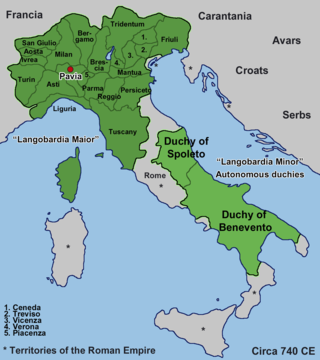Related Research Articles

Hildegard, was a Frankish queen consort who was the second wife of Charlemagne and mother of Louis the Pious. Little is known about her life because like all other women related to Charlemagne, she became notable only from a political background with records on her parentage, wedding, death and role as a mother.

Menia was the queen of the Thuringians by marriage and the earliest named ancestor of the Gausian dynasty of the Lombards. She became a legendary figure after her death, strongly associated with gold and wealth.

The County of Loon was a county in the Holy Roman Empire, which corresponded approximately with the modern Belgian province of Limburg. It was named after the original seat of its count, Loon, which is today called Borgloon. During the middle ages the counts moved their court to a more central position in Kuringen, which today forms part of Hasselt, capital of the province.

Gilbert was son of Reginar and the brother-in-law of the Ottonian emperor, Otto I. He was duke of Lotharingia until 939. Gilbert was also lay abbot of Echternach, Stablo-Malmedy, St Servatius of Maastricht, and St Maximin of Trier.
Conrad I was Duke of Swabia from 983 until 997. His appointment as duke marked the return of Conradine rule over Swabia for the first time since 948.

Boniface III, son of Tedald of Canossa and the father of Matilda of Tuscany, was the most powerful north Italian prince of his age. By inheritance he was count of Brescia, Canossa, Ferrara, Florence, Lucca, Mantua, Modena, Pisa, Pistoia, Parma, Reggio, and Verona from 1007 and, by appointment, margrave of Tuscany from 1027 until his assassination in 1052.
Count Richar was a 10th-century Lotharingian count. He had a well-attested county in the Luihgau, a territory between Liège and Aachen, and he is generally considered to have held comital status in the County of Hainaut, possibly in the area of Mons.

The Kingdom of the Lombards, also known as the Lombard Kingdom and later as the Kingdom of all Italy, was an early medieval state established by the Lombards, a Germanic people, on the Italian Peninsula in the latter part of the 6th century. The king was traditionally elected by the very highest-ranking aristocrats, the dukes, as several attempts to establish a hereditary dynasty failed. The kingdom was subdivided into a varying number of duchies, ruled by semi-autonomous dukes, which were in turn subdivided into gastaldates at the municipal level. The capital of the kingdom and the center of its political life was Pavia in the modern northern Italian region of Lombardy.
Richelida or Richilda was a member of the dynasty known to historians as the Giselbertiners. Her second husband was Boniface III of Tuscany.
Giselbert II was the count of Bergamo. He was a member of the dynasty known to historians as the Giselbertiners.
Lanfranc I of Bergamo was a northern Italian nobleman. He was a member of the dynasty known to historians as the Giselbertiners.
Rotruda of Pavia was an Italian noblewoman. Rotruda was married to Giselbert I of Bergamo and later became the mistress of Hugh of Italy.
Werner, Count in Hesbaye was a count in Hesbaye, now in Belgium. During his life he held lands in the Condroz, and lands as far away as Zülpich, now in Germany. All the areas he was associated with were part of the Kingdom of Lotharingia, which during this period was no longer independent, but mainly under the control of Germany.
Count Giselbert of Loon or (later) Duras, was the deputy advocate (subadvocatus) of Saint Trudo’s Abbey. He was son of Otto I, Count of Duras, and his wife Oda. Giselbert was the first person to be named in contemporary documents as a count of Duras.
The County of Piacenza was a county of the Frankish kingdom of Italy. Its centre was the ancient and walled city of Piacenza at the confluence of the Trebbia and the Po, just downriver from the royal capital of Pavia. Much of the county was dominated by the Apennine Mountains. It roughly corresponds to the modern province of Piacenza.
Bertha of Rheinfelden, countess of Kellmünz, was the daughter of Rudolf of Rheinfelden and wife of Ulrich X of Bregenz.
Sophia of Formbach, was the daughter of Meginhard V of Formbach. She was countess of Salm through her marriage to Hermann of Salm, who was also elected German anti-king from 1081 to 1088.
Baldrick II was bishop of Liège from 1008 to his death at Heerewaarden in what is now the Netherlands.
Willa of Spoleto was the daughter of Boniface I, duke of Spoleto. Through marriage to Hubert, Duke of Spoleto Willa became duchess of Spoleto and margravine of Tuscany.

Jörg Jarnut was a German historian who was Chair of Medieval History at the University of Paderborn from 1983 to 2007.
References
- F. Menant, ‘Les Giselbertins, comtes du comté de Bergame et comtes palatins,’ in Formazione e strutture dei ceti dominanti nel medioevo (1988), pp. 115–186.
- J. Jarnut, Bergamo 568-1098. Verfassungs-, Sozial- und Wirtschaftsgeschichte einer lombardischen Stadt im Mittelalter (Wiesbaden, 1977).
- E. Hlawitschka, Franken, Alemannen, Bayern und Burgunder in Oberitalien, 774-962: Zum Verständnis der fränkischen Königsherrschaft in Italien (Freiburg im Breisgau, 1960), accessible online at: Genealogie Mittelalter
- Jean Baptiste David. Manuel de l'histoire de Belgique Vanlinthout, (1853) p. 171 et seq. (in French)